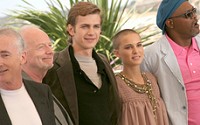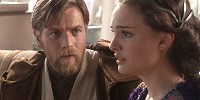 STAR WARS: Meet the Jedi
STAR WARS: Meet the Jedi
THE PREQUELS | THE PHANTOM MENACE | ATTACK OF THE CLONES | REVENGE OF THE SITH | GALLERIES

 When he accepted the role as Anakin, he knew the character would have to turn into Darth Vader, but he still wasn't prepared for some of the grim scenes in Episode III, such as the slaughter of the younglings. 'It took me by surprise when I read it in the script for the first time,' he says. 'It was a necessary evil though; all the Jedi have to go, even the children. It's a dark film and Anakin does some pretty dark things on that downward spiral.'
When he accepted the role as Anakin, he knew the character would have to turn into Darth Vader, but he still wasn't prepared for some of the grim scenes in Episode III, such as the slaughter of the younglings. 'It took me by surprise when I read it in the script for the first time,' he says. 'It was a necessary evil though; all the Jedi have to go, even the children. It's a dark film and Anakin does some pretty dark things on that downward spiral.'
McDiarmid chimes in: 'It's true, there's a Shakespearean tragic arc to his character.'
Christensen definitely prefers playing his character's morally dark periods to the more heroic scenes. 'This was the time in Anakin's life that I'd been looking forward to,' he says, 'making that dark transition to Darth Vader. There's just more fun to be had, more emotions to explore. I really enjoyed this one. Of course, it's a daunting task taking on a role that has such attention on it, as much as you try to disregard it. There are a few scenes that are very pivotal that were a challenge. The one between myself, Ian and Sam Jackson is a big one. You go to work those days ready to deliver. Thankfully, George had conceived a well-rounded character that was easy to follow in the script. So I was able to follow his lead.'
And of course working with veterans like Christopher Lee was helpful. 'He's full of tips,' Christensen says. 'He's full of stories. What a man — a well of knowledge and experience, and happy to share it all. He's one that I always try to sit down whenever I can and get a story or two out of him.'
Did it help in your climactic fight that Lee has done more on-screen swordfights than any other living actor? 'Well, he's done more films than any other living actor!'
When all is said and done, it turns out that Daniels has the first line in the first film, and the last line in this one. 'I didn't realise that I had the last line in this movie, because sometimes the scripts change,' he says. 'I had the first line in the first movie which was: "Did you hear that? They've shut down the main reactor! There'll be no escape for the princess this time." I didn't really know what I was talking about; I'd never been in a film before and I thought it was weird. Then George and I, 28 years later, walk into a soundstage in Australia and see the same set. It was an extremely odd jump. And the last line here is not the most Shakespearean of lines: "Oh no!" But what was great was Jimmy Smits is such a nice guy, and he came up to me and said, "How can I say just wipe his mind like that — it's hurtful and rude." I said, "Think of him as a washing machine. He's a household object, he doesn't feel."'
Suddenly there's a buzz in the room, a door opens and George Lucas himself walks in, looking surprisingly like an Ewok — shortish, roundish and rather hairy. The three actors perk up when they see him, giving him warm greetings before leaving to do whatever it is they have to do now. And George takes the hot seat. He's strikingly genuine and engaging, chatting openly and showing his passion for this universe he's created, but also a kind of weariness, and a sense of relief that it's all over.
He begins by talking about the overwhelming pressures he felt to make the prequels. 'Ultimately I had to push that a lot in my life and say that I would continue to make the movie that I started out to make,' he says. 'Fortunately the whole thing was written and the style was set before Star Wars was successful. So I could say that was what I was doing, and I would keep my eye on that ball and try to hit it straight.'
Obviously, back in 1977 he had no idea he would be here now. 'It's one of those things that happens in life,' he says. 'You go where the opportunities are and where your interests seem to lead you. You have to remember that originally Star Wars was intended to be one movie, Episode IV of a Saturday matinee serial. You never saw what came before or what came after. It was designed to be the tragedy of Darth Vader. It starts with this monster coming through the door, throwing everybody around, then halfway through the movie you realise that the villain of the piece is actually a man, and the hero is his son. And the villain turns into the hero, inspired by the son.
'So it was meant to be one movie, but I broke it up because I didn't have the money to do that movie, which would have been five hours long. And as the icon of Darth Vader took over, the tragedy of Darth Vader got diminished. It was harder to see that it was actually a story about a guy who becomes redeemed.
'But at the same time I'd written a back-story of all the characters in order to get to Episode IV. I did a biography of every character, what they were, who they were and where they came from, and exposition of where the Empire came from and all that sort of thing. So when I went back through the back-stories I really didn't intend to do that, I really intended to do the one movie, and then I was determined to do the three movies and get that one movie finished. I finished it and said that was fine. I was done.'
This contradicts what Lucas was saying, in the late-70s and early 80s, about a nine-movie cycle made up of three trilogies, which he said he'd mapped out in some detail. But then, he's known for drastically revising history — changing his films and insisting that the new editions are the only ones that now exist, that they're the films he intended to make from the beginning.
Today he denies there was ever anything planned for episodes VII to IX. And he says that at the time, 'the back-stories were written as back-stories; they weren't written as a movie, and technically you couldn't do it because you'd have to go to the centre of the universe. Star Wars was designed for technical reasons to be on the edge of the universe, so I didn't have to deal with that many costume problems, special effects problems or design problems. Then after about 10 years, beginning to think about the fact that the tragedy part of it had been lost, I thought it would be interesting to tell people the full story of what happened and strengthen that part of it.'
The big change was that special effects could now create almost anything on screen. 'The technology became available for me to be able to tell that story,' he says, 'to go into the centre of the universe, to see Coruscant, to see Yoda fighting and to see these things that were technically impossible before.'
And even with the technology available, he wasn't sure. 'I had a long soul-searching time,' he says. 'I really stopped making movies so I could raise my kids, and I did that for 15 years. And when they were old enough, I said I would go and direct again. Was I going to go off and do these avant-garde movies that I had intended to do, or was I going to take one last shot at Star Wars and tell the back-story, and tell it so the tragedy becomes more apparent? I realised that if I didn't do it then, when I was 50, I'd probably never get around to it. I said I'd do it because I thought I'd regret it if I didn't.'
So how does he feel now that it's all finished? Is there a sense of loss? 'It's more like having your kids go off to college,' he says. 'They still come back when they need money. They'll be there for holidays. We're doing a TV series; I'm not really involved with it, but we're doing two of them actually. They're not about the tragedy of Darth Vader — one is an animated series about the Clone Wars. All the characters are in it but obviously there's not much character arc. And one is a live-action series, but it's about minor characters in the saga.
'So it's still going to be around. I'm going to go off and do my thing, the world is going to go off and do theirs — or the company anyway — but the comic books, the novels and the games that are out there, it's sort of going to have a life of its own. So it is sort of like sending the kids off to college. Now it's on its own, it's going to be doing its own thing. But I sort of reserved the theatrical arena for this saga, which as I say started out as a two-hour idea and turned into a 12-hour idea.'
Looking back at the entire saga, Lucas knows which character he most identifies with: 'I would say probably Luke. That's where it started. He was a farm boy like I was, and went off to fight in the galactic wars.' 


ANTHONY DANIELS FILMOGRAPHY
Star Wars Episode III:
Revenge of the Sith (2005)
Star Wars Episode II:
Attack of the Clones (2002)
Star Wars Episode I:
The Phantom Menace (1999)
I Bought a Vampire Motorcycle (1990)
Star Wars Episode VI:
Return of the Jedi (1983)
Star Wars Episode V:
The Empire Strikes Back (1980)
The Lord of the Rings (1978)
Star Wars Episode IV:
A New Hope (1977)
IAN McDIARMID FILMOGRAPHY
Star Wars Episode III:
Revenge of the Sith (2005)
Star Wars Episode II:
Attack of the Clones (2002)
Sleepy Hollow (1999)
Star Wars Episode I:
The Phantom Menace (1999)
Restoration (1995)
Dirty Rotten Scoundrels (1988)
Gorky Park (1983)
Star Wars Episode VI:
Return of the Jedi (1983)
Dragonslayer (1981)
Star Wars Episode V:
The Empire Strikes Back (1980)
Sir Henry at Rawlinson End (1980)
The Awakening (1980)
Richard's Things (1980)
The Likely Lads (1976)






